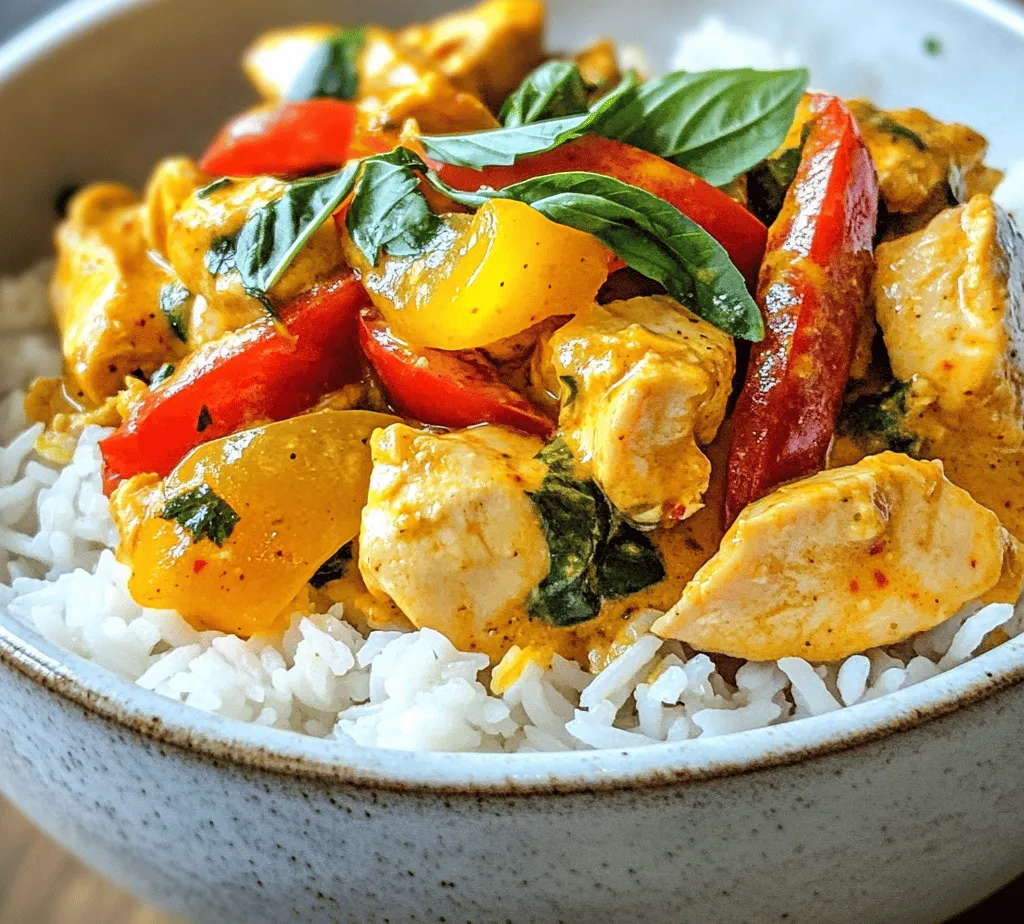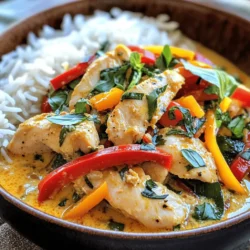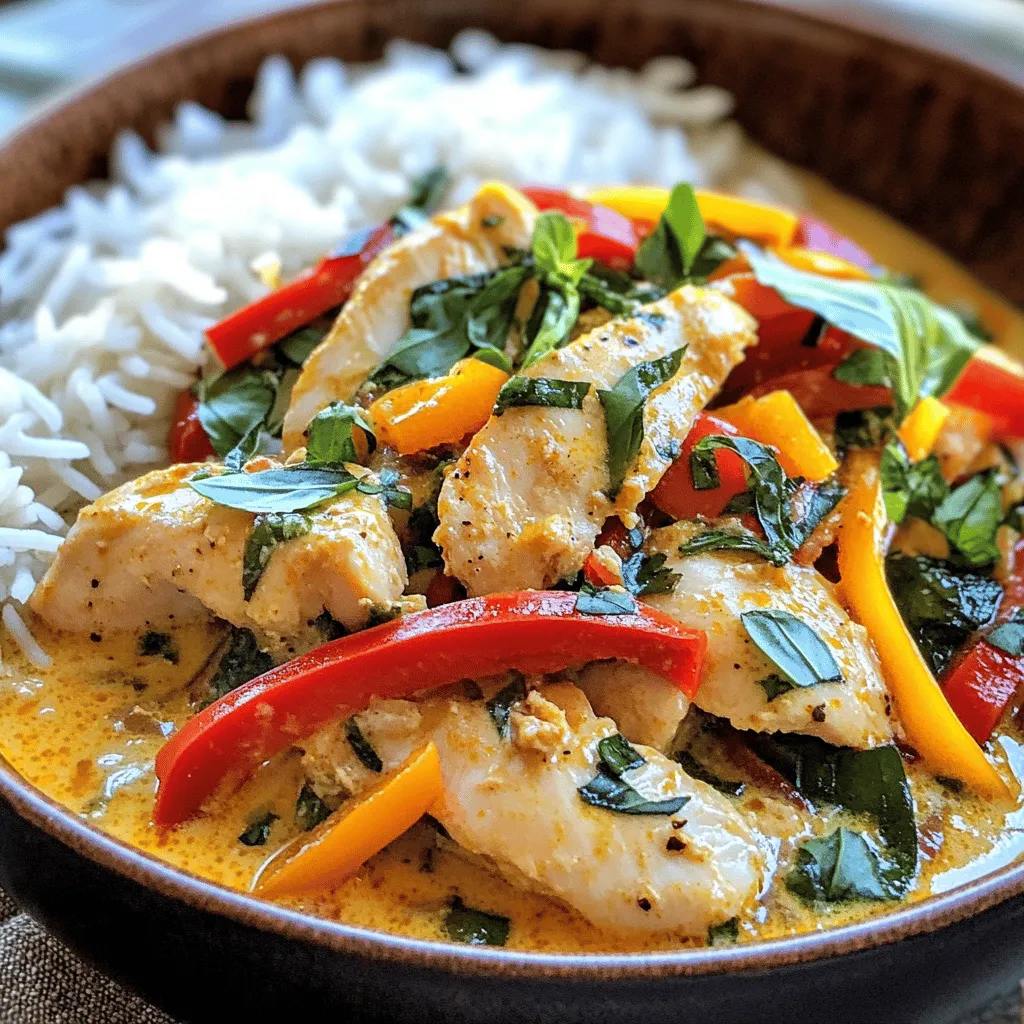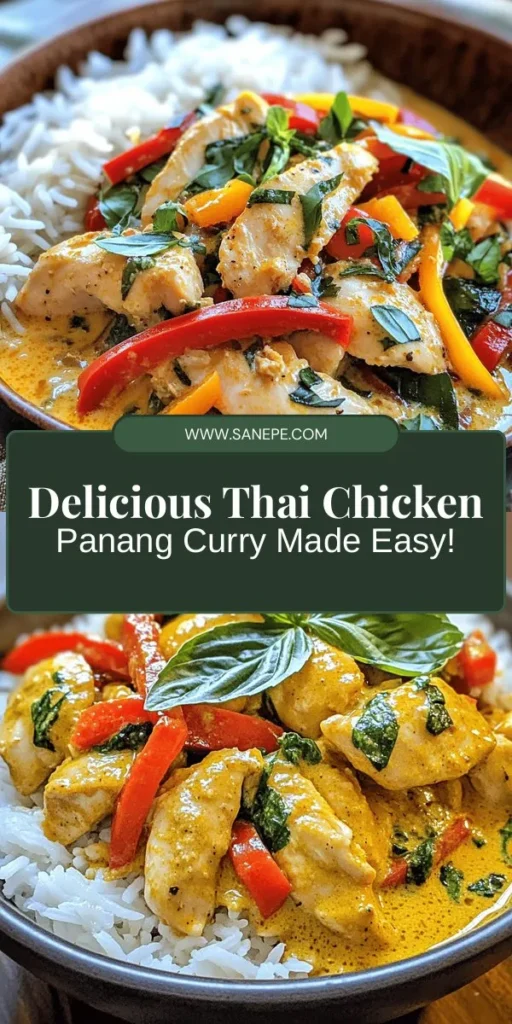Introduction
Thai cuisine is renowned for its vibrant flavors, aromatic spices, and colorful presentations that tantalize the taste buds. Each dish is a beautiful balance of sweet, salty, sour, and spicy elements, creating a sensory experience that is both delightful and satisfying. Among the many culinary gems that Thailand has to offer, Panang curry stands out as one of the most beloved and recognizable dishes. With its rich and creamy texture, aromatic spices, and a perfect blend of flavors, Panang curry has captured the hearts of food lovers around the world.
This recipe for the Best Thai Chicken Panang Curry is not only delicious but also surprisingly easy to prepare, making it a perfect choice for both novice cooks and seasoned chefs. The combination of tender chicken, fragrant spices, and creamy coconut milk creates a dish that is comforting and indulgent, yet light enough to be enjoyed any day of the week. Additionally, the ingredients in this recipe offer numerous health benefits, ensuring that you can indulge without guilt.
Understanding Thai Curries
To fully appreciate Panang curry, it’s essential to understand the broader category of Thai curries. Thai curries are typically categorized into several types, primarily differentiated by the color of the curry paste used and the cooking techniques involved. The most common types include red curry, green curry, yellow curry, and Panang curry. Each variety features a unique blend of ingredients and flavor profiles.
What Makes Panang Curry Unique?
Panang curry, originating from the central region of Thailand, is known for its thicker, creamier consistency compared to other curries. This dish is characterized by its use of coconut milk, which lends a rich, velvety texture, and its signature Panang curry paste, a blend of red chili, lemongrass, galangal, and other spices. While red curry is spicier and green curry tends to have a fresher, more herbal flavor, Panang curry strikes a balance with its slightly sweet, nutty undertones.
The flavor profile of Panang curry is more nuanced, often described as being aromatic and slightly sweet, courtesy of the palm sugar used in the recipe. The addition of kaffir lime leaves and Thai basil adds layers of complexity and freshness that elevate this dish to new heights.
Ingredients Breakdown
Creating the Best Thai Chicken Panang Curry starts with the right selection of ingredients. Each component contributes to the overall flavor and health benefits of the dish.
Boneless, Skinless Chicken Thighs
For this recipe, boneless, skinless chicken thighs are the preferred choice due to their tender texture and rich flavor. Thighs contain more fat than chicken breasts, allowing them to remain juicy even after cooking. If you prefer a leaner option, chicken breasts can be used, but be aware that they may require careful cooking to prevent dryness. For a different twist, feel free to substitute chicken with tofu for a vegetarian version or use shrimp for a seafood option.
Coconut Milk
Coconut milk is a cornerstone of Thai cooking, providing a creamy base that balances the heat of the spices. It plays a crucial role in achieving the characteristic texture of Panang curry. Nutritionally, coconut milk is rich in healthy fats and provides a good source of vitamins C and E. Additionally, it contains minerals such as magnesium and potassium, which contribute to overall health.
Panang Curry Paste
The heart and soul of Panang curry is the curry paste itself. This vibrant blend typically includes red chili peppers, garlic, shallots, lemongrass, galangal, kaffir lime leaves, and shrimp paste. While you can purchase pre-made Panang curry paste at the store, making your own allows for greater control over the flavors and spice levels. Homemade pastes can be customized to suit personal preferences, ensuring a more authentic taste.
Vegetable Oil
When cooking, it’s essential to choose the right type of oil. Vegetable oil is commonly used for sautéing, but options like coconut oil or peanut oil can also be suitable for their unique flavors. Each oil has different smoke points, so ensure you select one that can withstand the cooking method you are using.
Fish Sauce
Fish sauce is a quintessential ingredient in Thai cuisine, adding depth and umami to dishes. It is made from fermented fish and is typically used sparingly due to its potent flavor. For those following a vegetarian or vegan diet, soy sauce or tamari can serve as a suitable substitute, although the flavor will differ slightly.
Palm Sugar vs. Brown Sugar
In this recipe, palm sugar is used to impart a gentle sweetness that balances the other flavors. Palm sugar has a distinct caramel-like taste and is often preferred in Thai cooking. If palm sugar is unavailable, light brown sugar can be used as a substitute, though it may impart a slightly different flavor profile.
Red Bell Pepper
Red bell peppers add a pop of color and sweetness to the curry. They are high in vitamins A and C, making them a nutritious addition. Their vibrant hue enhances the visual appeal of the dish, making it as pleasing to the eye as it is to the palate.
Thai Basil
This fragrant herb is crucial for authentic Thai dishes. Thai basil has a unique flavor profile, with a hint of anise and a slightly spicy taste. It is used fresh at the end of cooking to maintain its bright flavor. If you can’t find Thai basil, regular sweet basil can be used, but the flavor will differ.
Kaffir Lime Leaves
While optional, kaffir lime leaves are highly recommended for their aromatic qualities. They add a distinct citrus flavor that enhances the overall taste of the curry. If unavailable, a small amount of lime zest can be used as a substitute, although the flavor will not be as intense.
Jasmine Rice
No Thai curry is complete without a serving of jasmine rice. This fragrant rice variety pairs perfectly with the creamy sauce, soaking up the rich flavors. Jasmine rice is also a great source of carbohydrates, providing the energy needed for a fulfilling meal.
Step-by-Step Cooking Instructions
Now that we’ve gathered all the essential ingredients, it’s time to dive into the cooking process. Here, we will outline the key steps to create your Best Thai Chicken Panang Curry.
Sautéing the Curry Paste
The first step in making Panang curry is sautéing the curry paste. Begin by heating a tablespoon of vegetable oil in a large pan over medium heat. Once the oil is hot, add the Panang curry paste. Sautéing the paste is crucial as it releases the essential oils and flavors, intensifying the aroma of the dish. Allow the paste to cook for about 2-3 minutes, stirring frequently to prevent burning. You’ll know it’s ready when it becomes fragrant and starts to darken slightly.
Tips for Preventing Burning: Keep a close eye on the heat, adjusting it as necessary. If you notice the paste starting to stick to the pan or burn, add a splash of coconut milk to loosen it up. This not only prevents burning but also helps in developing a richer flavor.
Cooking the Chicken
Once the curry paste is sautéed, it’s time to add the chicken. Cut the boneless, skinless chicken thighs into bite-sized pieces for even cooking. Add the chicken to the pan, stirring well to coat it with the curry paste. Cook the chicken for about 5-7 minutes, or until it is no longer pink on the outside.
Techniques for Ensuring Even Cooking: To ensure the chicken cooks evenly, make sure the pieces are similar in size. Stir frequently to promote even cooking and flavor absorption. Using chicken thighs will help retain tenderness, but if you choose chicken breasts, be cautious not to overcook them, as they can dry out quickly.
Adding Coconut Milk
After the chicken has cooked through, it’s time to add the coconut milk. Pour in one can of coconut milk, stirring well to combine with the chicken and curry paste. Bring the mixture to a gentle simmer and allow it to cook for another 10-15 minutes. This step is crucial as it allows the flavors to meld together, resulting in a rich and savory sauce.
As the curry simmers, you can adjust the consistency to your preference by adding more coconut milk or water if desired. The longer you let it simmer, the more the flavors will deepen, creating a complex and aromatic dish that is sure to impress.
Final Thoughts
This introduction to the Best Thai Chicken Panang Curry sets the stage for a delightful cooking experience that will transport you to the bustling streets of Thailand. With its rich flavors, aromatic spices, and healthy ingredients, this curry is sure to become a favorite in your household. Stay tuned for the next part of this recipe, where we will explore more cooking instructions and tips for achieving the perfect Panang curry.

How to Achieve the Perfect Consistency
Creating the perfect consistency for your Thai Chicken Panang Curry is crucial to achieving that luxurious, creamy texture that pairs beautifully with rice. Here are some essential steps to help you achieve that desired consistency:
1. Use Full-Fat Coconut Milk: Opt for full-fat coconut milk instead of light varieties. The richness of full-fat coconut milk gives the curry its creamy texture while enhancing the overall flavor. If you prefer a lighter version, you can mix half coconut milk with half vegetable broth, but keep in mind this will alter the velvety consistency.
2. Adjust the Liquid: If your curry turns out too thick, add a little water or chicken broth to thin it out. On the other hand, if it’s too runny, let it simmer on low heat uncovered to reduce and thicken the sauce.
3. Simmer Gently: Cooking the curry over low to medium heat allows the flavors to meld together while avoiding separation of the coconut milk. High heat can cause the coconut milk to curdle, leading to an unappealing texture.
Tips for Preventing Curdling
Curdling can be a common issue when working with coconut milk, but with these tips, you can ensure a smooth, creamy curry:
– Avoid Boiling: Never let the curry reach a rolling boil. As mentioned, keep it at a gentle simmer to maintain the integrity of the coconut milk.
– Add Coconut Milk Last: Incorporate the coconut milk towards the end of the cooking process. This way, it has less time to react to high heat, reducing the risk of curdling.
– Stir Gently: When mixing in the coconut milk, use a gentle stirring motion. Vigorous stirring can break down the fat molecules, leading to separation.
Seasoning the Curry
Seasoning is essential to achieving a well-balanced Thai Chicken Panang Curry. Here’s how to enhance the flavors:
1. Fish Sauce: This is a key ingredient in Thai cooking. Start with a small amount, then taste and adjust as needed. Fish sauce provides a salty, umami flavor that elevates the dish.
2. Brown Sugar: This ingredient adds a touch of sweetness that balances the saltiness of the fish sauce and the heat from the chilies. Adjust the sugar based on your taste preference, but be careful not to overpower the other flavors.
3. Tamarind Paste: For a tangy touch, consider adding tamarind paste. This enhances the sweet and sour profile of the dish.
Balancing Flavors: Salty, Sweet, and Sour
Achieving balance in your curry is key to a delicious result. Here’s how to do it:
– Taste As You Cook: Regularly taste your curry as it cooks. This allows you to adjust the seasoning incrementally. If it’s too salty, add a bit more sugar; if it’s too sweet, a splash of fish sauce or tamarind can help.
– Layering Flavors: Add ingredients gradually. Start with the curry paste and meat, then add coconut milk, and finally season with fish sauce, sugar, and tamarind.
Suggestions for Adjusting Seasoning to Personal Preference
Personalizing your Panang Curry can make it even more enjoyable. Here are some suggestions:
– Spice Level: Adjust the heat by using fewer chilies or opting for milder varieties. If you enjoy spicy food, incorporate more bird’s eye chilies or a dash of chili flakes.
– Sweetness: If you prefer a sweeter curry, increase the quantity of sugar or add additional coconut milk. Conversely, reduce sugar if you like a more savory dish.
Incorporating Vegetables
Adding vegetables not only enhances the flavor but also boosts the nutritional value of your curry. Here are some tips on incorporating vegetables effectively:
The Role of Vegetables in Enhancing Flavor and Nutrition
Vegetables add texture, color, and nutrients to your dish. Common vegetables to include in Thai Chicken Panang Curry are:
– Bell Peppers: Their sweetness complements the spiciness of the curry.
– Carrots: They add a crunch and natural sweetness.
– Zucchini: A great way to add bulk without overpowering the dish.
Cooking Times for Optimal Texture
Different vegetables have varying cooking times. Here’s a quick guide:
– Bell Peppers: Add them during the last 5-7 minutes of cooking to maintain their crunch.
– Carrots: Slice thinly and add them earlier, about 10 minutes into cooking, so they soften adequately.
– Zucchini: Add zucchini towards the end of cooking as they cook quickly and can become mushy if overcooked.
Finishing with Fresh Herbs
Herbs are essential in Thai cuisine, providing freshness and complexity to dishes. Here’s how to incorporate them:
The Significance of Fresh Thai Basil in the Dish
Thai basil is a hallmark of many Thai dishes, including Panang Curry. Its slightly spicy and aromatic flavor enhances the overall taste. When adding fresh Thai basil:
– Add at the End: Stir in the basil just before serving to preserve its vibrant flavor and color. Cooking it too long can lead to wilting and loss of flavor.
Tips for Incorporating Herbs Without Losing Flavor
– Use Whole Leaves: Instead of chopping, add whole leaves for a more robust taste.
– Garnish Generously: Use fresh herbs as a garnish to enhance presentation and flavor.
Serving Suggestions
Presenting your Thai Chicken Panang Curry beautifully can elevate the dining experience. Here are some best practices:
Best Practices for Serving Thai Chicken Panang Curry
– Serve Hot: Make sure your curry is served hot. This enhances the flavors and aroma, making it more appealing.
– Use a Bowl: A deep bowl allows for a generous serving of curry and rice, making it easier to mix the two.
Suggested Accompaniments and Presentation Tips
Pair your curry with:
– Jasmine Rice: Fluffy jasmine rice is a classic and absorbs the delicious sauce perfectly.
– Cucumber Salad: A refreshing cucumber salad can balance the richness of the curry.
– Lime Wedges: Serve with lime wedges to add a zesty kick right before eating.
For presentation, consider garnishing the dish with extra basil leaves and a sprinkle of red chili slices for a pop of color.
Nutritional Information
Understanding the nutritional aspects of your dish can enrich your cooking experience. Here’s a breakdown:
Overview of Calories and Macronutrients Per Serving
A typical serving of Thai Chicken Panang Curry (1 cup) contains roughly:
– Calories: 350-400
– Protein: 20-25 grams
– Carbohydrates: 30-35 grams
– Fat: 20-25 grams
These values may vary based on ingredient quantities and types used.
Health Benefits of the Main Ingredients
– Chicken: A great source of lean protein, essential for muscle health.
– Coconut Milk: Contains healthy fats that promote heart health and provide energy.
– Vegetables: Add fiber, vitamins, and minerals, enhancing overall nutrition.
How to Make the Dish Healthier if Desired
– Reduce Sugar: Cut down on brown sugar to lower the caloric content.
– Lean Proteins: Use skinless chicken breast instead of thighs or substitute with tofu for a plant-based option.
Culinary Variations
Thai Chicken Panang Curry is versatile, allowing for various adaptations to suit dietary preferences.
Alternative Proteins
– Tofu: A great vegetarian option that absorbs flavors beautifully.
– Shrimp: Offers a different texture and flavor, making the dish lighter.
Vegetarian or Vegan Adaptations
To make a fully plant-based version:
– Use tofu or tempeh as the protein source.
– Substitute fish sauce with soy sauce or tamari for a vegan alternative.
Suggestions for Different Vegetables or Additions
Experiment with:
– Eggplant: Adds a creamy texture when cooked.
– Snap Peas: Introduce a sweet crunch, adding them at the last minute of cooking.
Cultural Significance
Understanding the role of Panang curry in Thai culture can enhance your appreciation of the dish.
The Role of Panang Curry in Thai Culture and Dining
Panang curry is often enjoyed during family meals and gatherings. It signifies warmth, hospitality, and the importance of sharing food with loved ones.
Importance of Family Meals in Thai Traditions
Family meals are a cornerstone of Thai culture. Dishes like Panang curry are made in larger portions to encourage sharing and togetherness.
How to Enjoy the Dish Authentically at Home
To create an authentic experience:
– Gather family or friends to share the meal.
– Pair with traditional Thai beverages, such as Thai iced tea or coconut water.
Conclusion
Thai Chicken Panang Curry is a delightful dish that combines simplicity with an explosion of flavors. The creamy texture, aromatic spices, and ability to customize make it a perfect addition to any home-cooked meal. Whether you are a seasoned chef or a beginner, this curry is an excellent way to explore the rich flavors of Thai cuisine.
By following the tips and suggestions outlined, you can create a dish that not only satisfies your palate but also impresses your family and friends. Embrace the culinary adventure of making this dish a staple in your cooking repertoire, and enjoy the vibrant tastes of Thailand from the comfort of your home.


